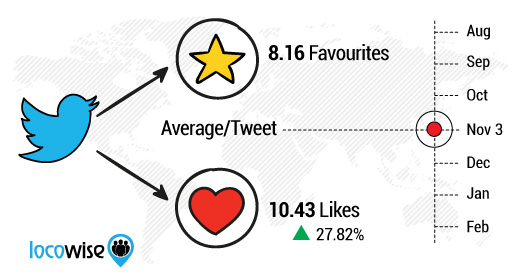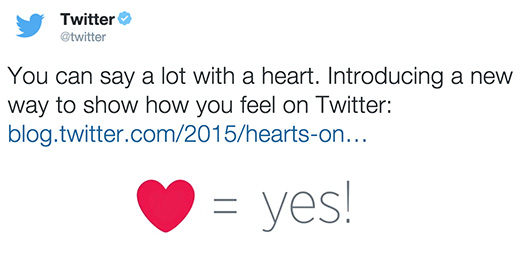
Twitter recently decided to change the rules a little – it can do that kind of thing, of course, because it runs the show. To switch things up, the platform decided to introduce "heart" button in place of the good old-fashioned star for "favorite" that everyone had known for years.
Most would consider this change to be cosmetic at best, but if you dig a little deeper, there are some people out there who think that the heart has changed the social media landscape dramatically.
Some like the change, many don't.
We've got the data so we decided to take a look and find out if the introduction of hearts has changed the way engagement takes place on the platform – we'll look at the details behind this change first and move to the numbers next.
Twitter has its own version of events as to how the change came about, and it has a clear definition of what a heart means on its own site. To quote:
"Likes are represented by a small heart. They are commonly used to show appreciation for a Tweet. You can see someone's likes by visiting their profile, and your likes are also visible on your profile."
So according to Twitter you're showing appreciation for a tweet by giving it a heart.
Then there's Chris Sacca. Sacca, a Twitter investor, wrote a long post back in June, 2015, which focused on where he wanted Twitter to put their focus. You can read the piece here (give it an hour to digest fully) – it discusses the platform in great detail. The good thing about the piece is the fact that Sacca genuinely loves the company, not just as a cash cow, but as a kind of 'mission company'. Read the piece, you'll see what we mean.
At one point in the piece, Sacca makes it clear that he feels that switching to hearts, instead of stars, will massively increase engagement on the platform. Many people have since shared Sacca's post, and it's well-known that Twitter executives have seen it too.
When was it written? June 3rd 2015.When were hearts instead of stars first explored by Twitter? June 2015.The official change from stars to hearts happened on November 3rd 2015So h?as it worked? Let's look at that next.Twitter feels the switch has brought an increase in engagement on their platform. Comments from Kevin Weil, their SVP of Product mention a 6% increase in activity for existing users and 9% increase for new users.
"We put a lot of thought into a change as fundamental as replacing star with heart. We tested it a bunch of different ways across a bunch of different countries. Trying different icons, different words. The heart is a universal symbol. It's a much more inclusive symbol."
We took a look at our numbers to see if we could learn more. The results may surprise you.

We looked at more than 1,500 Twitter profiles in the 3 month period before and 3 month period after the change to hearts. These profiles tweeted more than 2.2 million times receiving more than 21 million favorites in total during the 6 months.
An average tweet in the 3 months leading up to the change to hearts got 8.16 favorites. An average tweet in the 3 months since the change to hearts got 10.43 likes. This is a 27.82% increase in people using that one button and must be considered a major success for Twitter.
Have you noticed any difference in your engagement since the change to hearts? You can use our Twitter Analyser tool to have a quick look at how you're doing.
The word 'like' is where the issue lies for those who are against the new direction.
You go to a store, you buy their stuff, and after a few months you keep buying more of their stuff. Eventually, you begin to realize that you rate their stuff higher than another store's stuff.
One day you stumble across a review site that is rating and collating all the reviews and info on stores like the one you have been visiting for months. The store in question is staring at you from your screen. Underneath there is a chance to click on stars, with five stars making it a highly rated store in your opinion, and one star making it a poor option.
Makes perfect sense right? Quality is gauged by the number of stars a provider gains – this system's been in place for a long time, and it works.
But let's say that you look at the same store on the site and instead of stars underneath the details you see a group of hearts. Five hearts means… what?
That you love the store? That you are fond of it? Or simply that you rate it highly?
Twitter replacing stars with hearts is something that, to some people, changes the nature of how we interact with tweets. We no longer simply rate the quality of a tweet, we show our love for it and that is a whole new ball game.
The whole issue centres around the notion of 'favorites'. If you star something, you are giving it a favorite. This wasn't that hard a concept to understand – but if you give something a heart you're showing that there's an emotional weight attached to that action.
People used to star stuff on Twitter because it was an easy way to lock onto tweets they wanted to check out later. When you are sifting through tweets and find an important news item, you would star the tweet. You can simply come back to your favorites at a later date, and in that way have your Twitter life pretty much organzed. And that worked. It also meant that you were able to find tweets that were genuinely interesting to you.
This is a great idea for news-based tweets, for example – people could simply star their notable news tweets that had floated into their stream and keep an eye on events. From terrorist acts to celebrity weddings, it made for an easier way to navigate the Twitter experience.
But issues like terrorist events are also where the switch to hearts becomes problematic for some. Starring a terrorist event to read a tweet about it later makes perfect sense – the tweet is notable, it rates highly because it's of interest. But adding a heart to a news tweet about a terrorist event? That, arguably, makes for a slightly more uncomfortable experience.
Twitter will have to deal with this perhaps. Doing this would mean categorising tweets, and Twitter is all about self-expression. Pushing a tweet into a bracket and not allowing hearts while all other tweets get the chance to receive hearts… it just makes everything messy. For now we're stuck with a new system that allows people to 'spread the love' about horrible news events.

Take a look at the tweet that gave us the launch video. Watch the launch video and see why people are starting to think Twitter may have missed out on something here. The video is all about love and passion and all of that social media stuff that works on other platforms.
Most platforms face bumps along the road of their growth, but it's all about taking a look at what is going on and trying to change for the better without losing your core fans. That's what Twitter's trying to do with hearts, the algorithmic timeline and other experiments.
The problem for Twitter is that they have many die hard fans who love the platform as it is and don't want it to change in any shape or form.
With Twitter continuing to slide on the stock market, is making their loyal fans unhappy a gamble they can take? They need to, and the first 3 months of data shows that the change to hearts has paid off in a big way.
The post Has Twitter's Change Of Heart Worked? Here's The Data appeared first on Locowise Blog.
Want Social Media Today updates in your inbox?View the original article here
Original source: Has Twitter's Switch to Hearts Worked? Here's The Data.
http://www.jretechnology.com
No comments:
Post a Comment
Note: Only a member of this blog may post a comment.